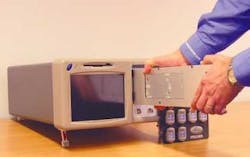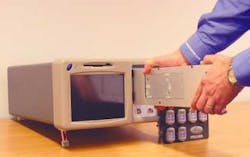Component companies ready for new measures
To survive, passive-component vendors must react to changes in market direction and requirements as they occur. This need for flexibility is particularly true in the testing arena. Volumes are low, and customers face different requirements. Manufacturers must contend with a broad component mix, so the ability to change the production line and associated measurement capabilities as quickly as possible is critical. As product lifecycles get shorter, rapid changes in measurement requirements will make it harder to strike the balance between flexibility and automation efficiency. The consistency in CMOS or other semiconductor production lines will not become the norm in optical components for a long time.
Standard measurements for passive components are loss-based: return loss, insertion loss, polarization-dependent loss, and crosstalk. Today, however, systems builders worry about futureproofing their products and they want their suppliers to provide components that can also meet the needs of 40-Gbit/sec networks. Passive components must therefore satisfy the dispersion specifications of faster networks, so group delay and differential group delay/polarization-mode dispersion are now on the list of measured parameters.
This demand for flexibility is behind the emergence of modular measurement-system architectures that allow users to reconfigure test equipment as requirements change—the wavelength range of the source, total parameters measured, and number of channels simultaneously tested. This flexibility offers a level of futureproofing and other benefits such as reducing capital expenditures long-term and training requirements. Modularity also enables mechanical changes to the system and reduces downtime because repairs are faster to execute while sparing is simplified.
Passive-component manufacturers must also reduce production costs. With up to half the production costs of a component attributed to testing, one of the primary ways to achieve this reduction is to cut the cost of measurement. This cost-cutting is a balance between the accuracy of the measurement, price of the test equipment, and time taken to perform the measurement. Clearly, simply buying the cheapest test system is not the most effective solution. A more accurate system, for instance, can improve production yields by reducing waste. Likewise, a system that can cut measurement times will reduce cycle time and labor costs and thereby cover its extra initial cost in a matter of weeks.
Measurements, of course, are performed at many points in the development and production process. More measurement detail and control is required during research and development than during production (see accompanying sidebar, "When to measure? Same parameter, different test stages"). So although the same parameter may be measured at different times, the characteristics of the measurement system required at each step can be very different. Careful attention to user interface design enables the same instrument to cater to these various needs.
One area where flexibility is critical but also relatively easy to achieve is in the control software. The software should allow users to perform the measurement directly from the test set and remotely over a network where a central computer jointly controls the manufacture and test. All test systems designed for use in a production environment should offer a roadmap for eventual integration with automation equipment.
Different measurement techniques also can have a marked effect on flexibility and performance. In the case of all-parameter measurement of components, two main techniques have been developed: the phase-shift technique and swept homodyne interferometry (SHI). In the phase-shift technique, a modulated beam is passed through the device under test and a phase-sensitive detector measures the delay introduced by the component. With SHI, the phase information is derived from the interferogram as the wavelength is swept.
SHI can be very fast but typically lacks the dynamic range of phase-shift techniques and is not suitable for long fiber components. Vibration is always an issue in production environments, so test systems must use anti-vibration mounts if this factor is found to affect the measurement.
As growing numbers of components are used in networks, each individual component must introduce low loss and delay to ensure the network stays within its specified performance budget. High measurement resolution is therefore required to ensure the component under test will be suitable for use in high-data-rate networks. Typically, a delay accuracy of about 0.05 psec and a measurement range of 40 dB are required to capture the large changes at the edge of the passband of these components.
As the channel count in components increases, there is a natural move from single-channel measurement to simultaneous multichannel measurement to keep the test time manageable. But just how many channels does it make sense to measure simultaneously? The realistic channel count required at the moment is 40 for devices such as arrayed-waveguide DWDMs, but this number will increase over time. Today, the smaller channel counts such as four and eight are far more common.
A second application of multichannel test systems is to speed the production of single-channel components by measuring many similar components in parallel. That is often the case with dispersion compensating devices where a dozen components can simultaneously undergo Telcordia testing in an environmental chamber. Test equipment must offer a modular architecture to provide a cost-effective solution at current channel counts and an upgrade path to more channels.
The demand to measure multiple channels also requires a degree of flexibility. To measure a 1×N demultiplexer, a single source and N receivers are required. To measure an N×1 multiplexer, the reverse is true and for a multichannel (M×N) test, multiple sources and receivers are required. Currently, due to the complexity of the test, all-parameter measurements are moving first to 1×N tests and from there to M×N simultaneous systems. Modular test systems offer the flexibility to adapt to the measurement requirements as the test complexity increases.
As the number of channels measured increases, significant challenges emerge. Test instrumentation has to be carefully designed to ensure that it is reasonable in terms of size and power consumption. Until recently, single-channel dispersion test systems could almost fill a 19-inch rack, so simply increasing the number of these systems for a 40-channel measurement was not an option. The latest multichannel test system designs provide measurement capability for 40 channels in a unit that only fills half a rack.
The route to more channels also has to be cost-efficient. When a single-channel test system can cost $200,000, it is prohibitively expensive to increase the channel count if that means a proportionate rise in price. The design of the instrument must make it cost-effective to upgrade to higher numbers of channels.
Time savings is the key benefit of multichannel measurements, so it's important that a multichannel system take no longer than a single-channel instrument to perform the measurement. That presents a major design challenge since the amount of data generated can be enormous. For a system measuring five parameters over 40 channels and taking a reading every 10 pm over the C- and L-bands, there are two million individual measurements. This information is generated in a matter of seconds and has to be processed, transferred to the main control unit, and displayed in some intelligible form to the user. That is a problem since displaying five measurement parameters from 40 channels simultaneously in a way that the pertinent information is easily visible to the user can be quite a challenge. Clearly "expert systems" embedded in the measurement software that automatically appraise the data and present an intelligent opinion to the user are beneficial here.
As passive-component test systems move from all-parameter tests to all-parameter, multichannel measurements, the flexibility of the test instrument is paramount. Optical- component manufacturers need to balance their current requirements for reduced expenditure with the flexibility to react to the rapidly changing component specifications of their customers—and to the increased volumes when the upturn comes. Test equipment manufacturers understand these conflicting requirements and now provide flexible, modular systems that fulfill current needs and provide an upgrade route to more measurements, greater channel counts, and larger measurement volumes.
Dr. Dan Daly is business development manager at PerkinElmer Optoelectronics (Wokingham, UK).
When to measure? Same parameter, different test stages
The same parameter is measured during a number of stages in the development and production of an optical component. Each stage places different demands on the measurement equipment. The four primary measurement stages are research and development, component specifications, production, and final conformance testing of the finished product. It is impractical to use a different test system for each stage, so the test equipment chosen must adapt to all requirements.
During the development stage, the test system is operated by an experienced engineer who fully understands the measurement technique, the component's behavior, and its interaction with the test equipment. The engineer therefore requires high levels of control over the test system to ensure the information needed from the new component is correctly obtained. In this instance, the flexibility and accuracy of the measurement is more important than the speed.
Once the development cycle is completed, the specifications for the new product, which are quoted to customers, require a high level of accuracy. In this case, as the repetition of these tests is limited, measurement speed is sacrificed to achieve the best possible accuracy.
During the production process, measurements are performed for two reasons. The first is to confirm that the manufacturing has been successful up to a certain stage, thereby avoiding unnecessary additional processing of a faulty part. Speed is crucial here since any time saved has a large effect on the cost of production. Accuracy is less important, but ease of use—typically one-button operation—is a key feature to reduce the chance of errors. The second reason to test during production is that real time measurements are often required to optimize certain parameters, particularly insertion loss and polarization-dependent loss, while components are being aligned. In this case, a highly accurate, absolute measurement is not required—it is simply necessary to be able to judge whether an action is improving the component. In many cases, the change can improve one channel while degrading another, hence the necessity to monitor all channels simultaneously. Once again, the important aspects are speed of measurement and ease of integration into the manufacturing process.
Once manufacture of the component is completed, a final evaluation is performed to ensure the device meets the required specifications. In this case, the number of components tested can range from each one produced to just one in a batch. If the measurement is fast enough, it's possible to provide a certificate or individual data sheet with every component sold. That provides greater confidence to the customer and reduces the need for "goods-in" testing (a customer's acceptance testing upon receipt of the product), thus saving the customer time and effort—a major customer benefit. Speed of testing is paramount, but the ability to customize the test report is also an important consideration.

